第02讲 简单句-2025学年英语初升高知识详细讲解
文档属性
| 名称 | 第02讲 简单句-2025学年英语初升高知识详细讲解 | 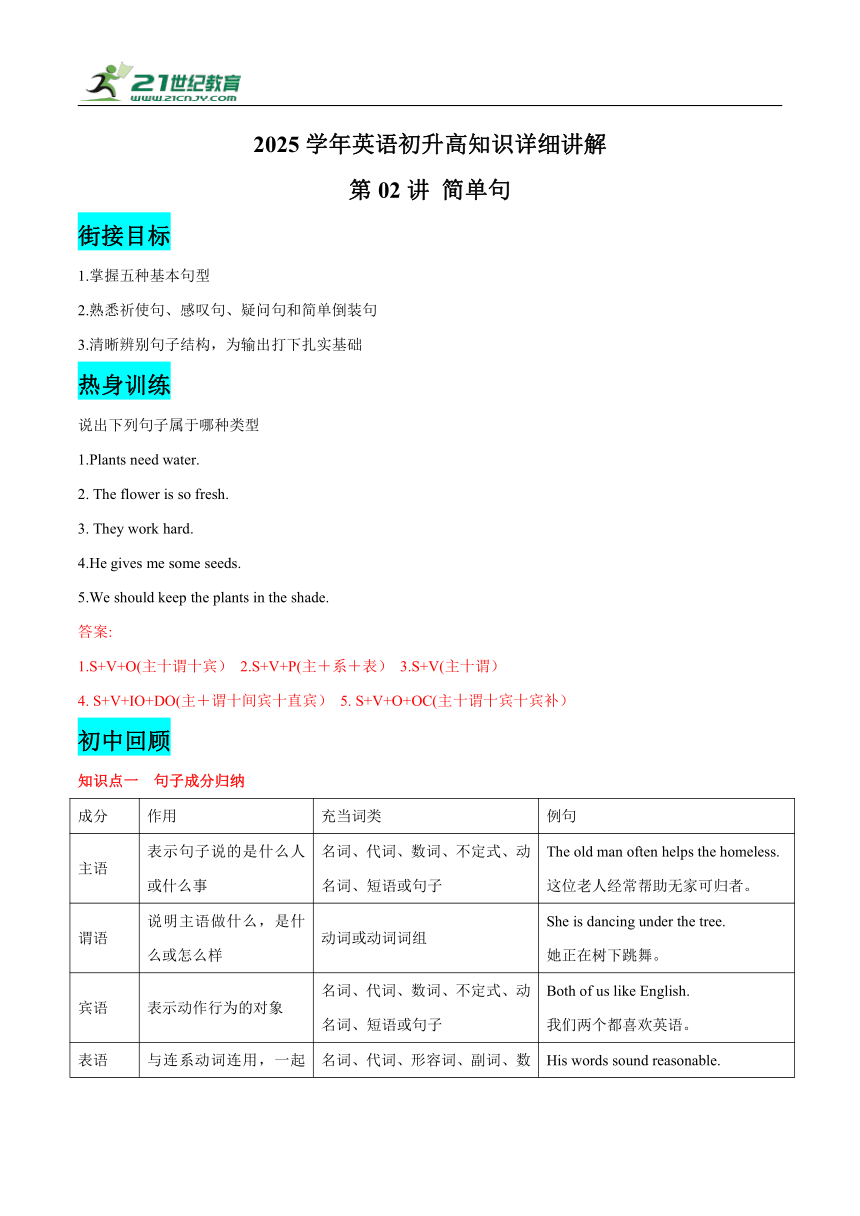 | |
| 格式 | docx | ||
| 文件大小 | 70.8KB | ||
| 资源类型 | 试卷 | ||
| 版本资源 | 人教新目标(Go for it)版 | ||
| 科目 | 英语 | ||
| 更新时间 | 2025-06-20 00:33:20 | ||
图片预览

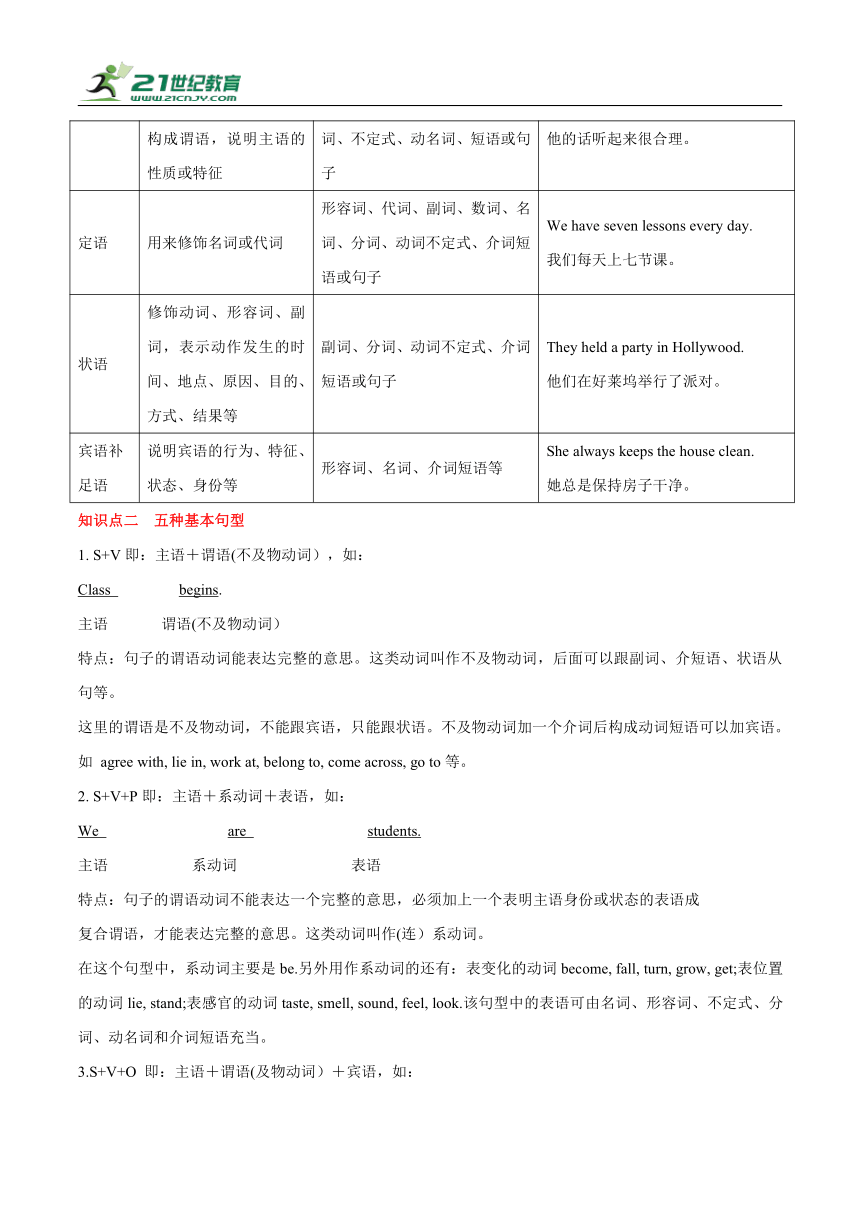
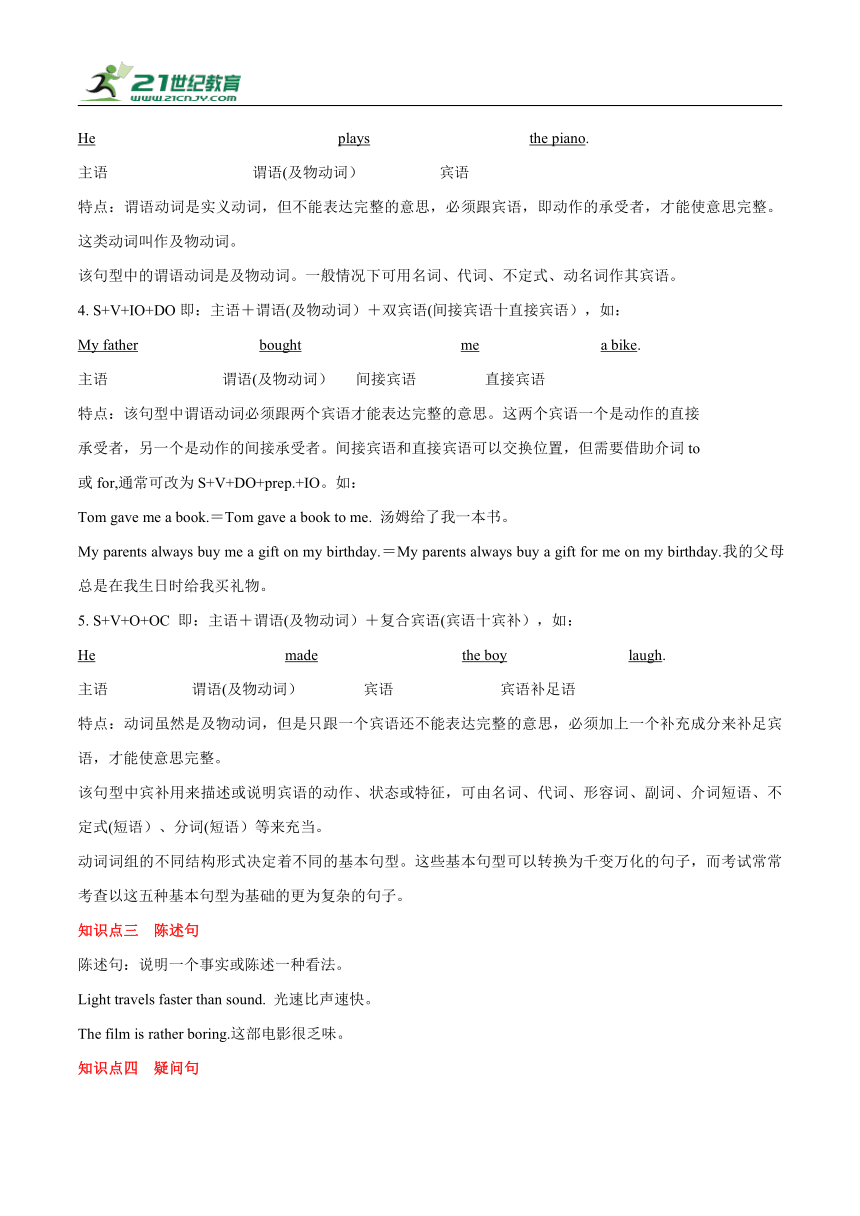
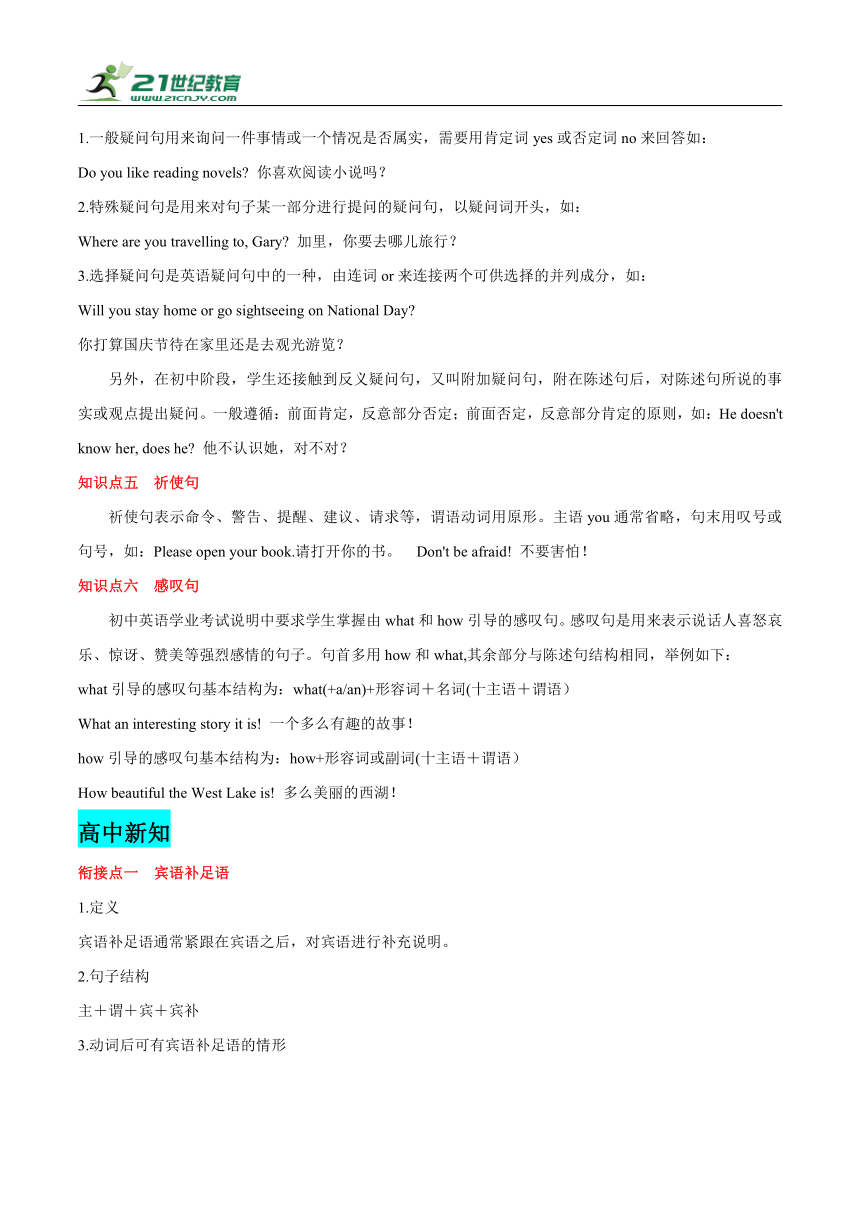
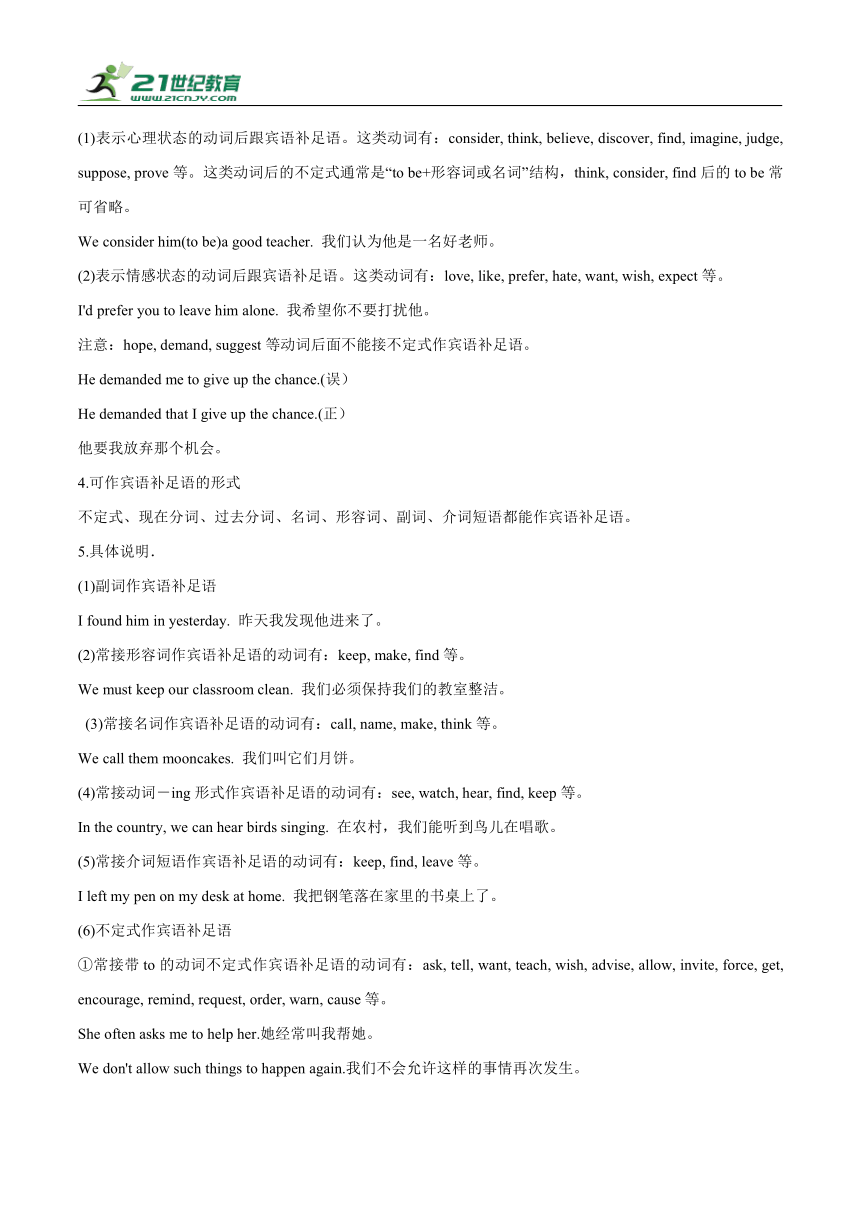
文档简介
2025学年英语初升高知识详细讲解
第02讲 简单句
街接目标
1.掌握五种基本句型
2.熟悉祈使句、感叹句、疑问句和简单倒装句
3.清晰辨别句子结构,为输出打下扎实基础
热身训练
说出下列句子属于哪种类型
1.Plants need water.
2. The flower is so fresh.
3. They work hard.
4.He gives me some seeds.
5.We should keep the plants in the shade.
答案:
1.S+V+O(主十谓十宾) 2.S+V+P(主+系+表) 3.S+V(主十谓)
4. S+V+IO+DO(主+谓十间宾十直宾) 5. S+V+O+OC(主十谓十宾十宾补)
初中回顾
知识点一 句子成分归纳
成分 作用 充当词类 例句
主语 表示句子说的是什么人或什么事 名词、代词、数词、不定式、动名词、短语或句子 The old man often helps the homeless. 这位老人经常帮助无家可归者。
谓语 说明主语做什么,是什么或怎么样 动词或动词词组 She is dancing under the tree. 她正在树下跳舞。
宾语 表示动作行为的对象 名词、代词、数词、不定式、动名词、短语或句子 Both of us like English. 我们两个都喜欢英语。
表语 与连系动词连用,一起构成谓语,说明主语的性质或特征 名词、代词、形容词、副词、数词、不定式、动名词、短语或句子 His words sound reasonable. 他的话听起来很合理。
定语 用来修饰名词或代词 形容词、代词、副词、数词、名词、分词、动词不定式、介词短语或句子 We have seven lessons every day. 我们每天上七节课。
状语 修饰动词、形容词、副词,表示动作发生的时间、地点、原因、目的、方式、结果等 副词、分词、动词不定式、介词短语或句子 They held a party in Hollywood. 他们在好莱坞举行了派对。
宾语补 足语 说明宾语的行为、特征、状态、身份等 形容词、名词、介词短语等 She always keeps the house clean. 她总是保持房子干净。
知识点二 五种基本句型
1. S+V即:主语+谓语(不及物动词),如:
Class begins.
主语 谓语(不及物动词)
特点:句子的谓语动词能表达完整的意思。这类动词叫作不及物动词,后面可以跟副词、介短语、状语从句等。
这里的谓语是不及物动词,不能跟宾语,只能跟状语。不及物动词加一个介词后构成动词短语可以加宾语。如 agree with, lie in, work at, belong to, come across, go to等。
2. S+V+P即:主语+系动词+表语,如:
We are students.
主语 系动词 表语
特点:句子的谓语动词不能表达一个完整的意思,必须加上一个表明主语身份或状态的表语成
复合谓语,才能表达完整的意思。这类动词叫作(连)系动词。
在这个句型中,系动词主要是be.另外用作系动词的还有:表变化的动词become, fall, turn, grow, get;表位置的动词lie, stand;表感官的动词taste, smell, sound, feel, look.该句型中的表语可由名词、形容词、不定式、分词、动名词和介词短语充当。
3.S+V+O 即:主语+谓语(及物动词)+宾语,如:
He plays the piano.
主语 谓语(及物动词) 宾语
特点:谓语动词是实义动词,但不能表达完整的意思,必须跟宾语,即动作的承受者,才能使意思完整。这类动词叫作及物动词。
该句型中的谓语动词是及物动词。一般情况下可用名词、代词、不定式、动名词作其宾语。
4. S+V+IO+DO即:主语+谓语(及物动词)+双宾语(间接宾语十直接宾语),如:
My father bought me a bike.
主语 谓语(及物动词) 间接宾语 直接宾语
特点:该句型中谓语动词必须跟两个宾语才能表达完整的意思。这两个宾语一个是动作的直接
承受者,另一个是动作的间接承受者。间接宾语和直接宾语可以交换位置,但需要借助介词to
或for,通常可改为S+V+DO+prep.+IO。如:
Tom gave me a book.=Tom gave a book to me. 汤姆给了我一本书。
My parents always buy me a gift on my birthday.=My parents always buy a gift for me on my birthday.我的父母总是在我生日时给我买礼物。
5. S+V+O+OC 即:主语+谓语(及物动词)+复合宾语(宾语十宾补),如:
He made the boy laugh.
主语 谓语(及物动词) 宾语 宾语补足语
特点:动词虽然是及物动词,但是只跟一个宾语还不能表达完整的意思,必须加上一个补充成分来补足宾语,才能使意思完整。
该句型中宾补用来描述或说明宾语的动作、状态或特征,可由名词、代词、形容词、副词、介词短语、不定式(短语)、分词(短语)等来充当。
动词词组的不同结构形式决定着不同的基本句型。这些基本句型可以转换为千变万化的句子,而考试常常考查以这五种基本句型为基础的更为复杂的句子。
知识点三 陈述句
陈述句:说明一个事实或陈述一种看法。
Light travels faster than sound. 光速比声速快。
The film is rather boring.这部电影很乏味。
知识点四 疑问句
1.一般疑问句用来询问一件事情或一个情况是否属实,需要用肯定词yes或否定词no来回答如:
Do you like reading novels 你喜欢阅读小说吗?
2.特殊疑问句是用来对句子某一部分进行提问的疑问句,以疑问词开头,如:
Where are you travelling to, Gary 加里,你要去哪儿旅行?
3.选择疑问句是英语疑问句中的一种,由连词or来连接两个可供选择的并列成分,如:
Will you stay home or go sightseeing on National Day
你打算国庆节待在家里还是去观光游览?
另外,在初中阶段,学生还接触到反义疑问句,又叫附加疑问句,附在陈述句后,对陈述句所说的事实或观点提出疑问。一般遵循:前面肯定,反意部分否定;前面否定,反意部分肯定的原则,如:He doesn't know her, does he 他不认识她,对不对?
知识点五 祈使句
祈使句表示命令、警告、提醒、建议、请求等,谓语动词用原形。主语you通常省略,句末用叹号或句号,如:Please open your book.请打开你的书。 Don't be afraid! 不要害怕!
知识点六 感叹句
初中英语学业考试说明中要求学生掌握由what和how引导的感叹句。感叹句是用来表示说话人喜怒哀乐、惊讶、赞美等强烈感情的句子。句首多用how和what,其余部分与陈述句结构相同,举例如下:
what引导的感叹句基本结构为:what(+a/an)+形容词+名词(十主语+谓语)
What an interesting story it is! 一个多么有趣的故事!
how引导的感叹句基本结构为:how+形容词或副词(十主语+谓语)
How beautiful the West Lake is! 多么美丽的西湖!
高中新知
衔接点一 宾语补足语
1.定义
宾语补足语通常紧跟在宾语之后,对宾语进行补充说明。
2.句子结构
主+谓+宾+宾补
3.动词后可有宾语补足语的情形
(1)表示心理状态的动词后跟宾语补足语。这类动词有:consider, think, believe, discover, find, imagine, judge, suppose, prove等。这类动词后的不定式通常是“to be+形容词或名词”结构,think, consider, find后的to be常可省略。
We consider him(to be)a good teacher. 我们认为他是一名好老师。
(2)表示情感状态的动词后跟宾语补足语。这类动词有:love, like, prefer, hate, want, wish, expect等。
I'd prefer you to leave him alone. 我希望你不要打扰他。
注意:hope, demand, suggest等动词后面不能接不定式作宾语补足语。
He demanded me to give up the chance.(误)
He demanded that I give up the chance.(正)
他要我放弃那个机会。
4.可作宾语补足语的形式
不定式、现在分词、过去分词、名词、形容词、副词、介词短语都能作宾语补足语。
5.具体说明.
(1)副词作宾语补足语
I found him in yesterday. 昨天我发现他进来了。
(2)常接形容词作宾语补足语的动词有:keep, make, find等。
We must keep our classroom clean. 我们必须保持我们的教室整洁。
(3)常接名词作宾语补足语的动词有:call, name, make, think等。
We call them mooncakes. 我们叫它们月饼。
(4)常接动词-ing形式作宾语补足语的动词有:see, watch, hear, find, keep等。
In the country, we can hear birds singing. 在农村,我们能听到鸟儿在唱歌。
(5)常接介词短语作宾语补足语的动词有:keep, find, leave等。
I left my pen on my desk at home. 我把钢笔落在家里的书桌上了。
(6)不定式作宾语补足语
①常接带to的动词不定式作宾语补足语的动词有:ask, tell, want, teach, wish, advise, allow, invite, force, get, encourage, remind, request, order, warn, cause等。
She often asks me to help her.她经常叫我帮她。
We don't allow such things to happen again.我们不会允许这样的事情再次发生。
Please remind me to leave her this note.. 请提醒我把这张便条留给她。
②接不带to的动词不定式作宾语补足语的动词有:see, watch, hear, make, let等。
I often see him play football. 我经常看到他踢足球。
注意:用不定式作宾语补足语的几种说明:
①help后面作宾语补足语的动词不定式可以带to也可以不带to.
I often help my mother(to) do some housework.我经常帮助妈妈做家务。
②一些动词跟不定式作宾语补足语时省去了to,这些动词有:一感二听三让四观看。一感:feel;二听:hear, listen to;三让:let, have, make;四观看:observe, see, watch, look at.
③在使役动词后作宾语补足语,不定式不带to.这类动词有:make, let, have等。转为被动语态时,其后通常都用带to的不定式(have没有被动语态)。
(7)掌握“使役动词 have+宾语+过去分词”的几种含义
在“have+宾语+过去分词”结构中,过去分词作宾语补足语,have也可用get.这一结构具有以下几种含义:
①意为“主语请别人做某事”。
He wants to have his eyes examined tomorrow.
他明天想去检查眼睛。(“检查”的动作由医生来进行)
②意为“主语遭遇、遭受某一不愉快、不测的事情”。
Be careful, or you'll have your hands hurt.当心,否则你会弄伤你的手。
③意为“使完成某事”,事情既可以是别人做完,也可以由主语参与完成。
He had the walls painted this morning.他今早给墙刷油漆了。(主语自己可能参与完成)
(8)分词作宾语补足语
用现在分词作宾补,说明宾语是动作的发出者,形成逻辑上的主谓关系;用过去分词作宾补,表示宾语是动作的承受者,构成逻辑上的动宾关系。跟分词作宾补的动词有:catch, have, get, keep, hear, find, feel, leave, make, want, start, notice, observe, watch, set等。
He found himself being looked after by an old woman.他发现一位老太太正在照顾他。
注意:几种用过去分词作宾语补足语的情况说明:
①表示“意欲;命令”的动词like, want, wish, order等后,可用过去分词作宾语补足语。
The father wants his daughter taught the piano.这位父亲想让女儿学钢琴。
②感官动词see, hear, notice, observe, watch, feel, find等后,可用过去分词作宾语补足语。
I saw an old man knocked down by a car just now.刚才我看到一位老人被车撞倒了。
③使役动词have, get, make, leave, keep等后,可用过去分词作宾语补足语。
Have you got your films developed 你把胶卷拿去冲洗了没有?
衔接点二 常见的祈使句句型
(1)以动词原形开头
Lay down your arms! 放下武器!
否定:Don't或Never+动词原形。。。
Never go out alone at night!不要在夜晚单独出去!
(2)Do+动词原形...(此句型表示强调)
Do tell her about it.务必将此事告诉她。
(3)以let开头
①Let's(包括说话对象)
Let's have another try. 咱们再试一下。
②Let us(不包括说话对象)
Let us have another try.让我们再试一下。
(4)主语+动词原形....
You, girls, clean the desk; you, boys, sweep the floor. 你们女生擦桌子。你们男生扫地。
(5)祈使句+and/or+陈述句(and表示顺承关系,or表示转折关系)
Use your head, and you'll find a good way.动动脑筋,你会找到一种好办法的。
Hurry up, or we'll be late. 快点,不然我们就迟到了。
(6)Be so kind/good as+不定式...(此句型用来表达客气的请求,so kind/good as相当于kind/good enough)
Be so kind as to lend me your dictionary. 请把你的字典借给我吧。
衔接点三 反义疑问句
(1)陈述部分的主语是I,谓语是am,疑问部分要用aren't I.
I'm as tall as your sister, aren't I 我跟你姐一样高,不是吗?
(2)陈述部分的谓语是wish,疑问部分要用may+主语。
I wish to have a word with you, may I 我想和你说句话,行吗?
(3)陈述部分用no, nothing, nobody, never, few, seldom, hardly, rarely, little等表示否定含义的词时,疑问部分用肯定式。
Some plants never bloom, do they 有些植物从不开花,对吗?
(4)含有ought to的反义疑问句,陈述部分是肯定的,疑问部分用shouldn't/oughtn't+主语。
He ought to know what to do, oughtn't he /shouldn't he 他应该知道该做什么,不是吗?
(5)陈述部分的谓语是used to时,疑问部分用didn't+主语或usedn't+主语。
He used to take pictures there ,didn't he /usedn't he 他以前常在那儿拍照,不是吗?
(6)陈述部分有had better+v.疑问部分用hadn't+主语。
You'd better read it by yourself, hadn't you
你最好自己去读,不是吗?
(7)陈述部分有 would rather+v.疑问部分多用wouldn't+主语。
He would rather read it ten times than reciteit, wouldn't he 他宁可读十遍也不愿意背诵,不是吗?
(8)陈述部分有You'd like to+v.,疑问部分用wouldn't+you
You'd like to go with me, wouldn't you 你想和我一块去,不是吗?
(9)陈述部分有must,疑问部分根据实际情况而定。
He must be a doctor, isn't he 他肯定是医生,不是吗?
You must have studied English for three years, haven't you /didn't you
你一定学过三年英语,不是吗?
He must have finished it yesterday, didn't he 他肯定是在昨天完成的,不是吗?
(10)感叹句中,疑问部分用否定的助动词+主语。
What colors, aren't they 多漂亮的颜色,不是吗?
(11)陈述部分主语是neither...nor...,either...or...连接的并列主语时,疑问部分根据其实际逻辑意
义而定。
Neither you nor I am an engineer, are we 你不是工程师,我也不是,对吗?
(12)陈述部分主语是指示代词或不定代词everything, that, nothing, this等,疑问部分主语用it.
Everything is ready, isn't it 一切就绪,不是吗?
(13)陈述部分主语是不定代词everybody, anyone, somebody, nobody, no one等,疑问部分常用复数they,有时也用单数he.
Everyone knows the answer, don't they (doen't he ) 人人都知道答案,不是吗?
Nobody knows about it, do they (does he ) 没人知道这件事,是吧?
(14)省去主语的祈使句的反义疑问句,疑问部分用 will you.
Don't do that again, will you 别再这样做,好吗?
Go with me, will you/won't you 跟我走吧,好吗?
注意:Let's开头的祈使句,后用shall we Let us 开头的祈使句,后用will you
Let's go and listen to the music, shall we 一起去听音乐,好吗?
Let us wait for you in the reading room, will you 让我们在阅览室等你,好吗?
(15)陈述部分是“there be”结构时,疑问部分用there作主语。
There is something wrong with your watch, isn't there 你的表有问题,对不对?
There will not be any trouble, will there 不会有麻烦,是吗?
(16)否定前缀不能视为否定词,其反义疑问句仍用否定形式。
It is impossible, isn't it 这不可能,是吗?
He is not unkind to his classmates, is he 他不会对他同学使坏,是吗?
巩固训练
一、用what, what a(n),或how完成下列感叹句
1._________ heavily it is snowing!
2. _________ terrible weather!
3. _________ exciting trip we had!
4. _________ sweet memories we had in Grade 7!
5. _________ exciting news it is to have several undergrounds in Changzhou soon!
答案:
1.How 2.What 3.What an 4.What 5.What
二、按要求改写句子
1. Jim moved somewhere quiet to start a new life.(改为一般疑问句)
_________ Jim move_________ quiet to start a new life
2.Jack used to read stories to his daughter when she was little.(改为否定句)
Jack_________ _________ to read stories to his daughter when she was little.
3. The doctor often advises us not to be too tired in work.(改为祈使句)
The doctor often says to us,“_________ _________ too tired in work.”
4.Mr Smith has taught in a primary school since he came to China.(对画线部分提问)
_________ _________ has Mr Smith taught in a primary school
5.My father liked soccer better than basketball when he was young.(改为同义句)
My father_________ soccer_________ basketball when he was young.
答案:
1.Did;anywhere 2.didn't use/used not 3. Don't be 4. How long 5. preferred; to
三、用括号内所给词的正确形式填空
1. They still had no idea how much danger_________ (face) when they accepted the task.
2.Let me_________ (tell) you what I saw last night.
3.After Anne died of illness, her father had her diary_________ (publish).
4.Well,that's the best way I could think of_________ (reach) an agreement with the customers.
5.If you happen to see a purse_________ (lie) in the street, what will you do
6. _________ (connect) the two cities, the high-speed railway plays an important role in our daily life.
7.He kept us_________ (read) the story once and again.
8.The boy was made_________ (stand) outside the room.
9.Jenny had her money_________ (steal).
10.She is often seen_________ (park) her car for over ten minutes because she is a green hand in driving.
答案:
1. to face 2. tell 3. published 4.to reach 5.lying
6.Connecting 7.reading 8.to stand 9.stolen 10.to park
四、完成下列反义疑问句
1. Let's go shopping tomorrow, _________ _________?
2.There is no need to compare yourself to anybody else, _________ _________?
3. They must clean the classroom before leaving the class, _________ _________?
4. I don't think he's been to America, _________ _________?
5. It's hardly rained for ten months in the area, _________ _________?
答案:
1. shall we 2. is there 3. mustn't/ needn't they 4.has he 5.has it
五、写出下列句子中画线部分的句子成分
1.The students got on the school bus. ( )
2. He handed me the newspaper. ( )
3.I shall answer your question after class. ( )
4. His job is to train swimmers. ( )
5.He took many photos of the places in Beijing. ( )
6.His wish is to become a scientist. ( )
7.He wants to finish the work in time( )
8.Tom came to ask me for advice. ( )
9.He found it important to master English. ( )
10.Do you have anything else to say ( )
答案:
1.谓语 2.直接宾语 3.状语 4.表语5.主语
6.表语 7.宾语 8.状语 9.宾语 10.定语
六、翻译下列句子,并写出其属于简单句中的哪种句型
1.威廉昨天买了一条漂亮的领带。
__________________________________________________________________________________
2.这朵花闻起来很香。
__________________________________________________________________________________
3.我的老师交给我一封信。
__________________________________________________________________________________
4.他告诉我不要在这里制造噪音。
__________________________________________________________________________________
5.我们叫我们的老师王先生。
__________________________________________________________________________________
答案:
1.William bought a beautiful tie yesterday.
S+V+O
2.The flower smells pleasant/good.
S+V+P
3.My teacher gave me a letter.
S+V+IO+DO
4.He told me not to make noise here.
S+V+O+OC
5.We call our teacher Mr Wang.
S+V+O+OC
第02讲 简单句
街接目标
1.掌握五种基本句型
2.熟悉祈使句、感叹句、疑问句和简单倒装句
3.清晰辨别句子结构,为输出打下扎实基础
热身训练
说出下列句子属于哪种类型
1.Plants need water.
2. The flower is so fresh.
3. They work hard.
4.He gives me some seeds.
5.We should keep the plants in the shade.
答案:
1.S+V+O(主十谓十宾) 2.S+V+P(主+系+表) 3.S+V(主十谓)
4. S+V+IO+DO(主+谓十间宾十直宾) 5. S+V+O+OC(主十谓十宾十宾补)
初中回顾
知识点一 句子成分归纳
成分 作用 充当词类 例句
主语 表示句子说的是什么人或什么事 名词、代词、数词、不定式、动名词、短语或句子 The old man often helps the homeless. 这位老人经常帮助无家可归者。
谓语 说明主语做什么,是什么或怎么样 动词或动词词组 She is dancing under the tree. 她正在树下跳舞。
宾语 表示动作行为的对象 名词、代词、数词、不定式、动名词、短语或句子 Both of us like English. 我们两个都喜欢英语。
表语 与连系动词连用,一起构成谓语,说明主语的性质或特征 名词、代词、形容词、副词、数词、不定式、动名词、短语或句子 His words sound reasonable. 他的话听起来很合理。
定语 用来修饰名词或代词 形容词、代词、副词、数词、名词、分词、动词不定式、介词短语或句子 We have seven lessons every day. 我们每天上七节课。
状语 修饰动词、形容词、副词,表示动作发生的时间、地点、原因、目的、方式、结果等 副词、分词、动词不定式、介词短语或句子 They held a party in Hollywood. 他们在好莱坞举行了派对。
宾语补 足语 说明宾语的行为、特征、状态、身份等 形容词、名词、介词短语等 She always keeps the house clean. 她总是保持房子干净。
知识点二 五种基本句型
1. S+V即:主语+谓语(不及物动词),如:
Class begins.
主语 谓语(不及物动词)
特点:句子的谓语动词能表达完整的意思。这类动词叫作不及物动词,后面可以跟副词、介短语、状语从句等。
这里的谓语是不及物动词,不能跟宾语,只能跟状语。不及物动词加一个介词后构成动词短语可以加宾语。如 agree with, lie in, work at, belong to, come across, go to等。
2. S+V+P即:主语+系动词+表语,如:
We are students.
主语 系动词 表语
特点:句子的谓语动词不能表达一个完整的意思,必须加上一个表明主语身份或状态的表语成
复合谓语,才能表达完整的意思。这类动词叫作(连)系动词。
在这个句型中,系动词主要是be.另外用作系动词的还有:表变化的动词become, fall, turn, grow, get;表位置的动词lie, stand;表感官的动词taste, smell, sound, feel, look.该句型中的表语可由名词、形容词、不定式、分词、动名词和介词短语充当。
3.S+V+O 即:主语+谓语(及物动词)+宾语,如:
He plays the piano.
主语 谓语(及物动词) 宾语
特点:谓语动词是实义动词,但不能表达完整的意思,必须跟宾语,即动作的承受者,才能使意思完整。这类动词叫作及物动词。
该句型中的谓语动词是及物动词。一般情况下可用名词、代词、不定式、动名词作其宾语。
4. S+V+IO+DO即:主语+谓语(及物动词)+双宾语(间接宾语十直接宾语),如:
My father bought me a bike.
主语 谓语(及物动词) 间接宾语 直接宾语
特点:该句型中谓语动词必须跟两个宾语才能表达完整的意思。这两个宾语一个是动作的直接
承受者,另一个是动作的间接承受者。间接宾语和直接宾语可以交换位置,但需要借助介词to
或for,通常可改为S+V+DO+prep.+IO。如:
Tom gave me a book.=Tom gave a book to me. 汤姆给了我一本书。
My parents always buy me a gift on my birthday.=My parents always buy a gift for me on my birthday.我的父母总是在我生日时给我买礼物。
5. S+V+O+OC 即:主语+谓语(及物动词)+复合宾语(宾语十宾补),如:
He made the boy laugh.
主语 谓语(及物动词) 宾语 宾语补足语
特点:动词虽然是及物动词,但是只跟一个宾语还不能表达完整的意思,必须加上一个补充成分来补足宾语,才能使意思完整。
该句型中宾补用来描述或说明宾语的动作、状态或特征,可由名词、代词、形容词、副词、介词短语、不定式(短语)、分词(短语)等来充当。
动词词组的不同结构形式决定着不同的基本句型。这些基本句型可以转换为千变万化的句子,而考试常常考查以这五种基本句型为基础的更为复杂的句子。
知识点三 陈述句
陈述句:说明一个事实或陈述一种看法。
Light travels faster than sound. 光速比声速快。
The film is rather boring.这部电影很乏味。
知识点四 疑问句
1.一般疑问句用来询问一件事情或一个情况是否属实,需要用肯定词yes或否定词no来回答如:
Do you like reading novels 你喜欢阅读小说吗?
2.特殊疑问句是用来对句子某一部分进行提问的疑问句,以疑问词开头,如:
Where are you travelling to, Gary 加里,你要去哪儿旅行?
3.选择疑问句是英语疑问句中的一种,由连词or来连接两个可供选择的并列成分,如:
Will you stay home or go sightseeing on National Day
你打算国庆节待在家里还是去观光游览?
另外,在初中阶段,学生还接触到反义疑问句,又叫附加疑问句,附在陈述句后,对陈述句所说的事实或观点提出疑问。一般遵循:前面肯定,反意部分否定;前面否定,反意部分肯定的原则,如:He doesn't know her, does he 他不认识她,对不对?
知识点五 祈使句
祈使句表示命令、警告、提醒、建议、请求等,谓语动词用原形。主语you通常省略,句末用叹号或句号,如:Please open your book.请打开你的书。 Don't be afraid! 不要害怕!
知识点六 感叹句
初中英语学业考试说明中要求学生掌握由what和how引导的感叹句。感叹句是用来表示说话人喜怒哀乐、惊讶、赞美等强烈感情的句子。句首多用how和what,其余部分与陈述句结构相同,举例如下:
what引导的感叹句基本结构为:what(+a/an)+形容词+名词(十主语+谓语)
What an interesting story it is! 一个多么有趣的故事!
how引导的感叹句基本结构为:how+形容词或副词(十主语+谓语)
How beautiful the West Lake is! 多么美丽的西湖!
高中新知
衔接点一 宾语补足语
1.定义
宾语补足语通常紧跟在宾语之后,对宾语进行补充说明。
2.句子结构
主+谓+宾+宾补
3.动词后可有宾语补足语的情形
(1)表示心理状态的动词后跟宾语补足语。这类动词有:consider, think, believe, discover, find, imagine, judge, suppose, prove等。这类动词后的不定式通常是“to be+形容词或名词”结构,think, consider, find后的to be常可省略。
We consider him(to be)a good teacher. 我们认为他是一名好老师。
(2)表示情感状态的动词后跟宾语补足语。这类动词有:love, like, prefer, hate, want, wish, expect等。
I'd prefer you to leave him alone. 我希望你不要打扰他。
注意:hope, demand, suggest等动词后面不能接不定式作宾语补足语。
He demanded me to give up the chance.(误)
He demanded that I give up the chance.(正)
他要我放弃那个机会。
4.可作宾语补足语的形式
不定式、现在分词、过去分词、名词、形容词、副词、介词短语都能作宾语补足语。
5.具体说明.
(1)副词作宾语补足语
I found him in yesterday. 昨天我发现他进来了。
(2)常接形容词作宾语补足语的动词有:keep, make, find等。
We must keep our classroom clean. 我们必须保持我们的教室整洁。
(3)常接名词作宾语补足语的动词有:call, name, make, think等。
We call them mooncakes. 我们叫它们月饼。
(4)常接动词-ing形式作宾语补足语的动词有:see, watch, hear, find, keep等。
In the country, we can hear birds singing. 在农村,我们能听到鸟儿在唱歌。
(5)常接介词短语作宾语补足语的动词有:keep, find, leave等。
I left my pen on my desk at home. 我把钢笔落在家里的书桌上了。
(6)不定式作宾语补足语
①常接带to的动词不定式作宾语补足语的动词有:ask, tell, want, teach, wish, advise, allow, invite, force, get, encourage, remind, request, order, warn, cause等。
She often asks me to help her.她经常叫我帮她。
We don't allow such things to happen again.我们不会允许这样的事情再次发生。
Please remind me to leave her this note.. 请提醒我把这张便条留给她。
②接不带to的动词不定式作宾语补足语的动词有:see, watch, hear, make, let等。
I often see him play football. 我经常看到他踢足球。
注意:用不定式作宾语补足语的几种说明:
①help后面作宾语补足语的动词不定式可以带to也可以不带to.
I often help my mother(to) do some housework.我经常帮助妈妈做家务。
②一些动词跟不定式作宾语补足语时省去了to,这些动词有:一感二听三让四观看。一感:feel;二听:hear, listen to;三让:let, have, make;四观看:observe, see, watch, look at.
③在使役动词后作宾语补足语,不定式不带to.这类动词有:make, let, have等。转为被动语态时,其后通常都用带to的不定式(have没有被动语态)。
(7)掌握“使役动词 have+宾语+过去分词”的几种含义
在“have+宾语+过去分词”结构中,过去分词作宾语补足语,have也可用get.这一结构具有以下几种含义:
①意为“主语请别人做某事”。
He wants to have his eyes examined tomorrow.
他明天想去检查眼睛。(“检查”的动作由医生来进行)
②意为“主语遭遇、遭受某一不愉快、不测的事情”。
Be careful, or you'll have your hands hurt.当心,否则你会弄伤你的手。
③意为“使完成某事”,事情既可以是别人做完,也可以由主语参与完成。
He had the walls painted this morning.他今早给墙刷油漆了。(主语自己可能参与完成)
(8)分词作宾语补足语
用现在分词作宾补,说明宾语是动作的发出者,形成逻辑上的主谓关系;用过去分词作宾补,表示宾语是动作的承受者,构成逻辑上的动宾关系。跟分词作宾补的动词有:catch, have, get, keep, hear, find, feel, leave, make, want, start, notice, observe, watch, set等。
He found himself being looked after by an old woman.他发现一位老太太正在照顾他。
注意:几种用过去分词作宾语补足语的情况说明:
①表示“意欲;命令”的动词like, want, wish, order等后,可用过去分词作宾语补足语。
The father wants his daughter taught the piano.这位父亲想让女儿学钢琴。
②感官动词see, hear, notice, observe, watch, feel, find等后,可用过去分词作宾语补足语。
I saw an old man knocked down by a car just now.刚才我看到一位老人被车撞倒了。
③使役动词have, get, make, leave, keep等后,可用过去分词作宾语补足语。
Have you got your films developed 你把胶卷拿去冲洗了没有?
衔接点二 常见的祈使句句型
(1)以动词原形开头
Lay down your arms! 放下武器!
否定:Don't或Never+动词原形。。。
Never go out alone at night!不要在夜晚单独出去!
(2)Do+动词原形...(此句型表示强调)
Do tell her about it.务必将此事告诉她。
(3)以let开头
①Let's(包括说话对象)
Let's have another try. 咱们再试一下。
②Let us(不包括说话对象)
Let us have another try.让我们再试一下。
(4)主语+动词原形....
You, girls, clean the desk; you, boys, sweep the floor. 你们女生擦桌子。你们男生扫地。
(5)祈使句+and/or+陈述句(and表示顺承关系,or表示转折关系)
Use your head, and you'll find a good way.动动脑筋,你会找到一种好办法的。
Hurry up, or we'll be late. 快点,不然我们就迟到了。
(6)Be so kind/good as+不定式...(此句型用来表达客气的请求,so kind/good as相当于kind/good enough)
Be so kind as to lend me your dictionary. 请把你的字典借给我吧。
衔接点三 反义疑问句
(1)陈述部分的主语是I,谓语是am,疑问部分要用aren't I.
I'm as tall as your sister, aren't I 我跟你姐一样高,不是吗?
(2)陈述部分的谓语是wish,疑问部分要用may+主语。
I wish to have a word with you, may I 我想和你说句话,行吗?
(3)陈述部分用no, nothing, nobody, never, few, seldom, hardly, rarely, little等表示否定含义的词时,疑问部分用肯定式。
Some plants never bloom, do they 有些植物从不开花,对吗?
(4)含有ought to的反义疑问句,陈述部分是肯定的,疑问部分用shouldn't/oughtn't+主语。
He ought to know what to do, oughtn't he /shouldn't he 他应该知道该做什么,不是吗?
(5)陈述部分的谓语是used to时,疑问部分用didn't+主语或usedn't+主语。
He used to take pictures there ,didn't he /usedn't he 他以前常在那儿拍照,不是吗?
(6)陈述部分有had better+v.疑问部分用hadn't+主语。
You'd better read it by yourself, hadn't you
你最好自己去读,不是吗?
(7)陈述部分有 would rather+v.疑问部分多用wouldn't+主语。
He would rather read it ten times than reciteit, wouldn't he 他宁可读十遍也不愿意背诵,不是吗?
(8)陈述部分有You'd like to+v.,疑问部分用wouldn't+you
You'd like to go with me, wouldn't you 你想和我一块去,不是吗?
(9)陈述部分有must,疑问部分根据实际情况而定。
He must be a doctor, isn't he 他肯定是医生,不是吗?
You must have studied English for three years, haven't you /didn't you
你一定学过三年英语,不是吗?
He must have finished it yesterday, didn't he 他肯定是在昨天完成的,不是吗?
(10)感叹句中,疑问部分用否定的助动词+主语。
What colors, aren't they 多漂亮的颜色,不是吗?
(11)陈述部分主语是neither...nor...,either...or...连接的并列主语时,疑问部分根据其实际逻辑意
义而定。
Neither you nor I am an engineer, are we 你不是工程师,我也不是,对吗?
(12)陈述部分主语是指示代词或不定代词everything, that, nothing, this等,疑问部分主语用it.
Everything is ready, isn't it 一切就绪,不是吗?
(13)陈述部分主语是不定代词everybody, anyone, somebody, nobody, no one等,疑问部分常用复数they,有时也用单数he.
Everyone knows the answer, don't they (doen't he ) 人人都知道答案,不是吗?
Nobody knows about it, do they (does he ) 没人知道这件事,是吧?
(14)省去主语的祈使句的反义疑问句,疑问部分用 will you.
Don't do that again, will you 别再这样做,好吗?
Go with me, will you/won't you 跟我走吧,好吗?
注意:Let's开头的祈使句,后用shall we Let us 开头的祈使句,后用will you
Let's go and listen to the music, shall we 一起去听音乐,好吗?
Let us wait for you in the reading room, will you 让我们在阅览室等你,好吗?
(15)陈述部分是“there be”结构时,疑问部分用there作主语。
There is something wrong with your watch, isn't there 你的表有问题,对不对?
There will not be any trouble, will there 不会有麻烦,是吗?
(16)否定前缀不能视为否定词,其反义疑问句仍用否定形式。
It is impossible, isn't it 这不可能,是吗?
He is not unkind to his classmates, is he 他不会对他同学使坏,是吗?
巩固训练
一、用what, what a(n),或how完成下列感叹句
1._________ heavily it is snowing!
2. _________ terrible weather!
3. _________ exciting trip we had!
4. _________ sweet memories we had in Grade 7!
5. _________ exciting news it is to have several undergrounds in Changzhou soon!
答案:
1.How 2.What 3.What an 4.What 5.What
二、按要求改写句子
1. Jim moved somewhere quiet to start a new life.(改为一般疑问句)
_________ Jim move_________ quiet to start a new life
2.Jack used to read stories to his daughter when she was little.(改为否定句)
Jack_________ _________ to read stories to his daughter when she was little.
3. The doctor often advises us not to be too tired in work.(改为祈使句)
The doctor often says to us,“_________ _________ too tired in work.”
4.Mr Smith has taught in a primary school since he came to China.(对画线部分提问)
_________ _________ has Mr Smith taught in a primary school
5.My father liked soccer better than basketball when he was young.(改为同义句)
My father_________ soccer_________ basketball when he was young.
答案:
1.Did;anywhere 2.didn't use/used not 3. Don't be 4. How long 5. preferred; to
三、用括号内所给词的正确形式填空
1. They still had no idea how much danger_________ (face) when they accepted the task.
2.Let me_________ (tell) you what I saw last night.
3.After Anne died of illness, her father had her diary_________ (publish).
4.Well,that's the best way I could think of_________ (reach) an agreement with the customers.
5.If you happen to see a purse_________ (lie) in the street, what will you do
6. _________ (connect) the two cities, the high-speed railway plays an important role in our daily life.
7.He kept us_________ (read) the story once and again.
8.The boy was made_________ (stand) outside the room.
9.Jenny had her money_________ (steal).
10.She is often seen_________ (park) her car for over ten minutes because she is a green hand in driving.
答案:
1. to face 2. tell 3. published 4.to reach 5.lying
6.Connecting 7.reading 8.to stand 9.stolen 10.to park
四、完成下列反义疑问句
1. Let's go shopping tomorrow, _________ _________?
2.There is no need to compare yourself to anybody else, _________ _________?
3. They must clean the classroom before leaving the class, _________ _________?
4. I don't think he's been to America, _________ _________?
5. It's hardly rained for ten months in the area, _________ _________?
答案:
1. shall we 2. is there 3. mustn't/ needn't they 4.has he 5.has it
五、写出下列句子中画线部分的句子成分
1.The students got on the school bus. ( )
2. He handed me the newspaper. ( )
3.I shall answer your question after class. ( )
4. His job is to train swimmers. ( )
5.He took many photos of the places in Beijing. ( )
6.His wish is to become a scientist. ( )
7.He wants to finish the work in time( )
8.Tom came to ask me for advice. ( )
9.He found it important to master English. ( )
10.Do you have anything else to say ( )
答案:
1.谓语 2.直接宾语 3.状语 4.表语5.主语
6.表语 7.宾语 8.状语 9.宾语 10.定语
六、翻译下列句子,并写出其属于简单句中的哪种句型
1.威廉昨天买了一条漂亮的领带。
__________________________________________________________________________________
2.这朵花闻起来很香。
__________________________________________________________________________________
3.我的老师交给我一封信。
__________________________________________________________________________________
4.他告诉我不要在这里制造噪音。
__________________________________________________________________________________
5.我们叫我们的老师王先生。
__________________________________________________________________________________
答案:
1.William bought a beautiful tie yesterday.
S+V+O
2.The flower smells pleasant/good.
S+V+P
3.My teacher gave me a letter.
S+V+IO+DO
4.He told me not to make noise here.
S+V+O+OC
5.We call our teacher Mr Wang.
S+V+O+OC
同课章节目录
